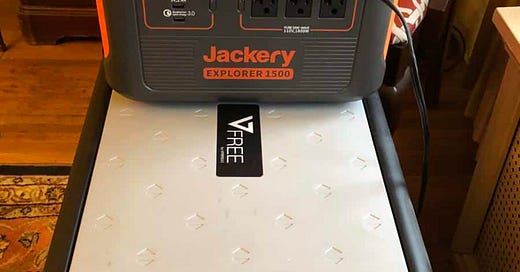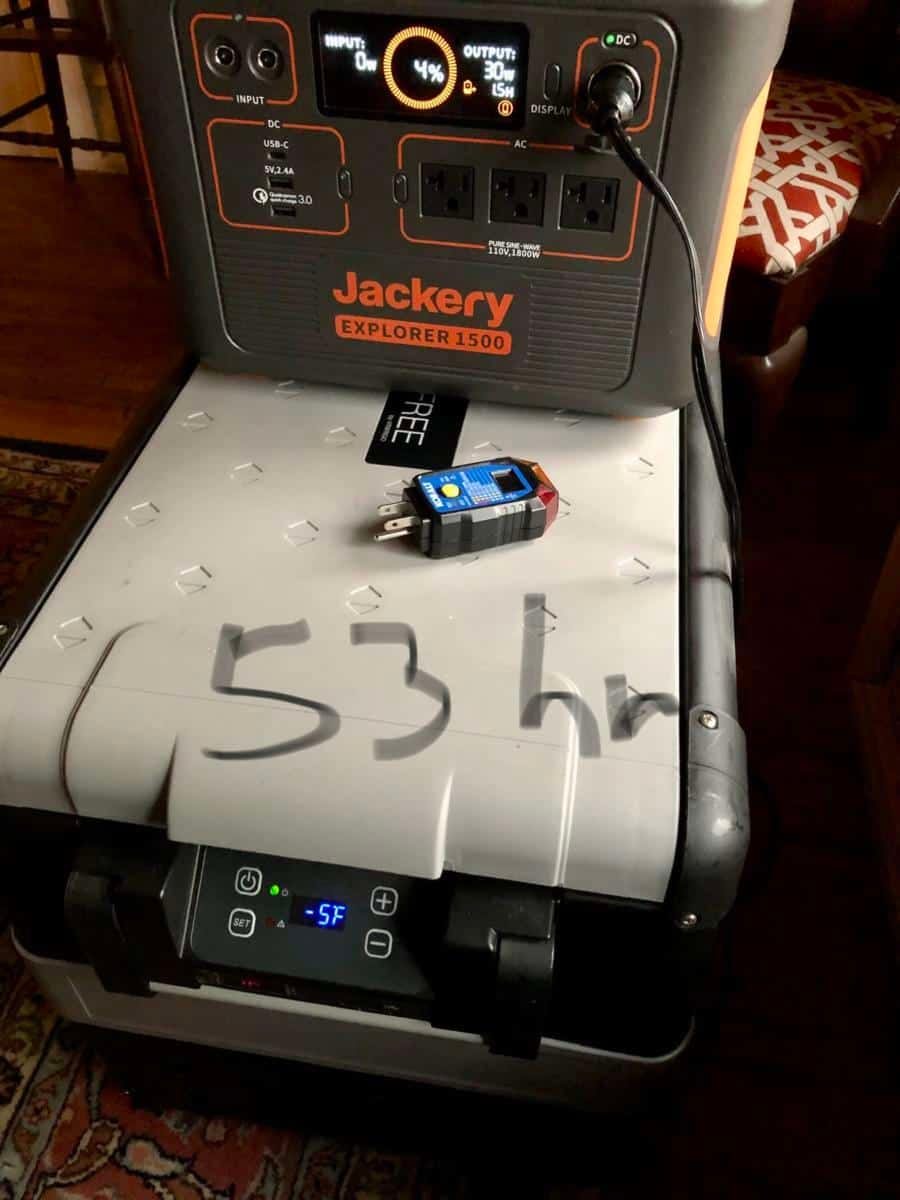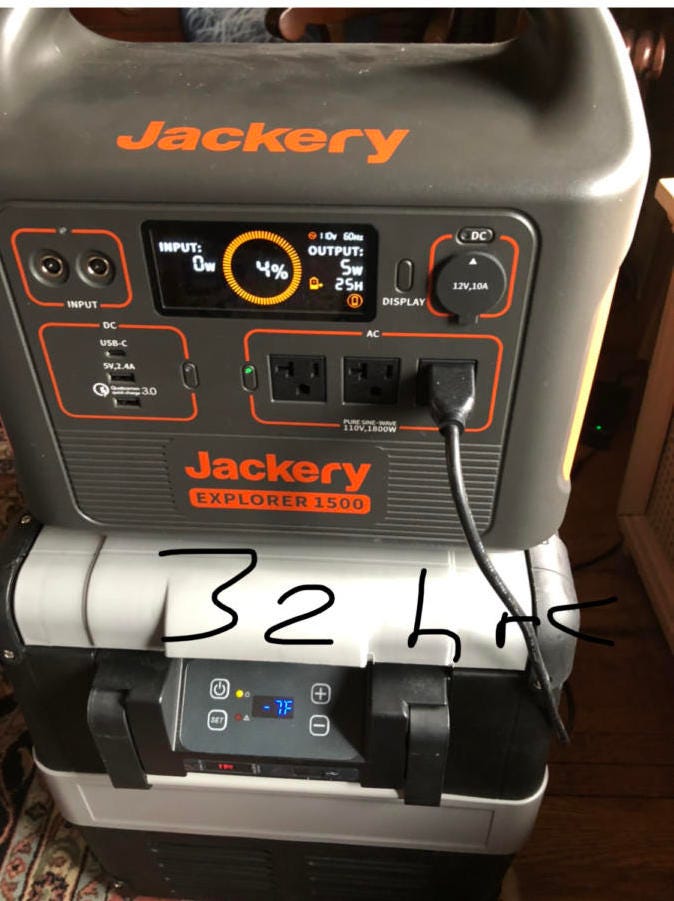Inverter loss: 12-volt vs 120-volt power usage
As promised, here's my battery usage test comparing the run time of a Vitrifrigo fridge/freezer on both 12-volts DC as well as through a 120-volt AC inverter.
Dear Readers
A few weeks ago I did an in-depth study of CEUs (Cappuccino Energy Units) as well as reviewed SPEUs (Sock Puppet Energy Units). Both of these are engineering estimates of how much energy is required to make a cup of Cappuccino (CEUs) or sew a sock puppet (SPEUs).
Fun, Fun, Fun on the Autobahn… (Thanks, Kraftwerk)
While these are just fun exercises, in reality it’s serious business if you’re boondocking and need to know how much battery charge you’re likely to use if you power an air fryer for 30 minutes or run a blender to make a frozen Margarita (I’ll call that MEU for Margarita Energy Units, I suppose).
This kind of intel can also tell you if your CPAP machine or electric blanket will run overnight, and how many solar panels you’re likely to need to recharge it during the day. And certainly it would be nice to know how long you could power a portable refrigerator/freezer with an RV house battery, or a Portable Power Station like the Jackery 1500.
Study time…
So today I’m going to present the basic data of how much battery power was needed to run a Vitrifrigo portable refrigerator/freezer while operating in a 70-degree room next to a steam radiator with the freezer temperature set to -7 degrees F.
And because I’m able to power this refrigerator directly from 12 volts DC (it has a 12-volt DC Danfoss compressor), I was also able to run a test using the 120-volt AC inverter output connected to a power supply that acted like a converter by converting 120 volts AC to 12 volts DC. Of course, there are two more voltage conversion steps as well as a fan running for the inverter, so I fully expected there to be a lot of wasted energy when running on 120 volts AC compared to 12 volts DC. And I was right…
Just the facts, ma’am…
This is a test using a Jackery Explorer 1500 with around 1,500 watt-hrs of stored energy. That’s equivalent to a 120 amp-hr lithium battery. (1,500 watt-hrs / 12.5 volts = 120 amp-hrs.) It’s powering a Vitrifrigo portable fridge/freezer set to -7 degrees F two different ways: by plugging into the 12-volt DC outlet directly, or plugging a power supply into the 120-volt AC outlet. In both cases the room was around 70 degrees F, but I placed the fridge a few inches away from a steam radiator to get the worst case Delta T (temperature difference) possible without going crazy.
Case #1: Run time on 12 volts DC
For this test I just plugged the Vitrifrigo portable fridge directly into the 12-volt DC outlet on the Jackery 1500, set the temp as low as it would go (-7 degrees F) and checked the State of Charge (SoC) occasionally. This is exactly how it would work if you connected one of these 12-volt DC refrigerators into your 12-volt battery supply in the RV.
These 12-volt Danfoss compressor refrigerators are really efficient, drawing perhaps 30 watts when running. As you can see, I was able to power the Vitrifrigo 12-volt DC fridge for 53 hours with 4% SoC left. So that’s easily 54 hours of run time on a single charge before the Jackery Power Station would shut off.
A little calculating…
So 1,500 watt-hrs divided by 54 hours equals around 28 watts average. We can reverse that formula to see how many amp-hours of 12-volt battery charge that would equal and end up with 28 watts / 12.5 volts = 2.25 amp-hrs per hour. That suggests a 100 amp-hr lithium battery would be able to power this fridge with 12 volts DC for around 45 hours of operation. For a 24-hr. period, that would be around 670 watt-hrs of energy.
Case #2: Run time on 120-volts AC
In this second scenario we have both an inverter in the Jackery running to step the 12 volts up to 120 volts AC, and a power supply brick running to convert the 120 volts AC back down to 12 volts DC for the Danfoss compressor.
This is exactly what would happen if you were to plug a 12-volt DC refrigerator into a 120-volt outlet in your RV that was powered by house batteries while boondocking. Of course, if you were plugged into a pedestal you wouldn’t be worrying about amp-hrs of usage. But when on battery power, every watt-hr counts.
As you can see, instead of 53 hours, I was able to power the same refrigerator at the same temperature for only 32 hours. Let’s call it 33 hours to go to 0% State of Charge just to be equal.
More calculating…
Once again, 1,500 watt-hrs divided by 33 hrs. equals 45 watts average power when running on 120 volts AC from the inverter. That’s a lot more than the 28 watts average power used by the same refrigerator running on 12 volts. So in a 24-hr. period that would require around 1,080 watt-hrs of energy to operate.
Wow, you really use a lot of extra energy when running on 120 volts AC simply due to the conversion efficiency losses in the inverter as well as the cooling fan, etc.
What about solar panels?
Well, the general rule is that a 100-watt solar panel should be able to provide around 300 watt-hrs of energy per day. Of course, this will vary with the time of the year, angle of the sun, clouds in the sky, etc. But 300 watt-hrs per day is a good place to start.
So in example #1 with the Vitrifrigo fridge powered by 12 volts DC, the 670 watt-hrs of energy needed every 24 hours would require around 200 watts or so of solar panels. But as along as the sun was shining, those 200 watts of solar panels would do a great job of keeping your beer and baloney cold. And a 100 amp-hr lithium battery could easily keep your fridge running for a full day without sunshine.
But in example #2, the same refrigerator running from 120 volts AC produced by an inverter in your RV would need about 1,080 watt-hrs of energy for a 24-hour period. Which works out to around 400 watts of solar panels needed to power this refrigerator continuously. That’s twice the number of solar panels just to run the refrigerator from an RV inverter compared to 12 volts DC.
What have we learned?
As much as we love our inverters, there’s a significant energy price to pay for their convenience, simply due to efficiency losses in the conversion process and system overhead (like the fan running in the inverter). This doesn’t work out to much on shore power, but boondocking is a different story. So while boondocking, whenever possible, run any small appliances from 12 volts DC rather than 120 volts AC from the inverter. And shut off your inverter when you’re not using it to provide AC power. Your RV battery could then last up to twice as long on a single charge while boondocking.
Let’s play safe out there…. Mike










Very interesting Mike. I do have one question though. Do you have any feel for how much of the loss using the 120v option was from the inverter vs. the power brick? Thanks for the info. --- Jim Carter